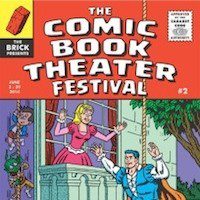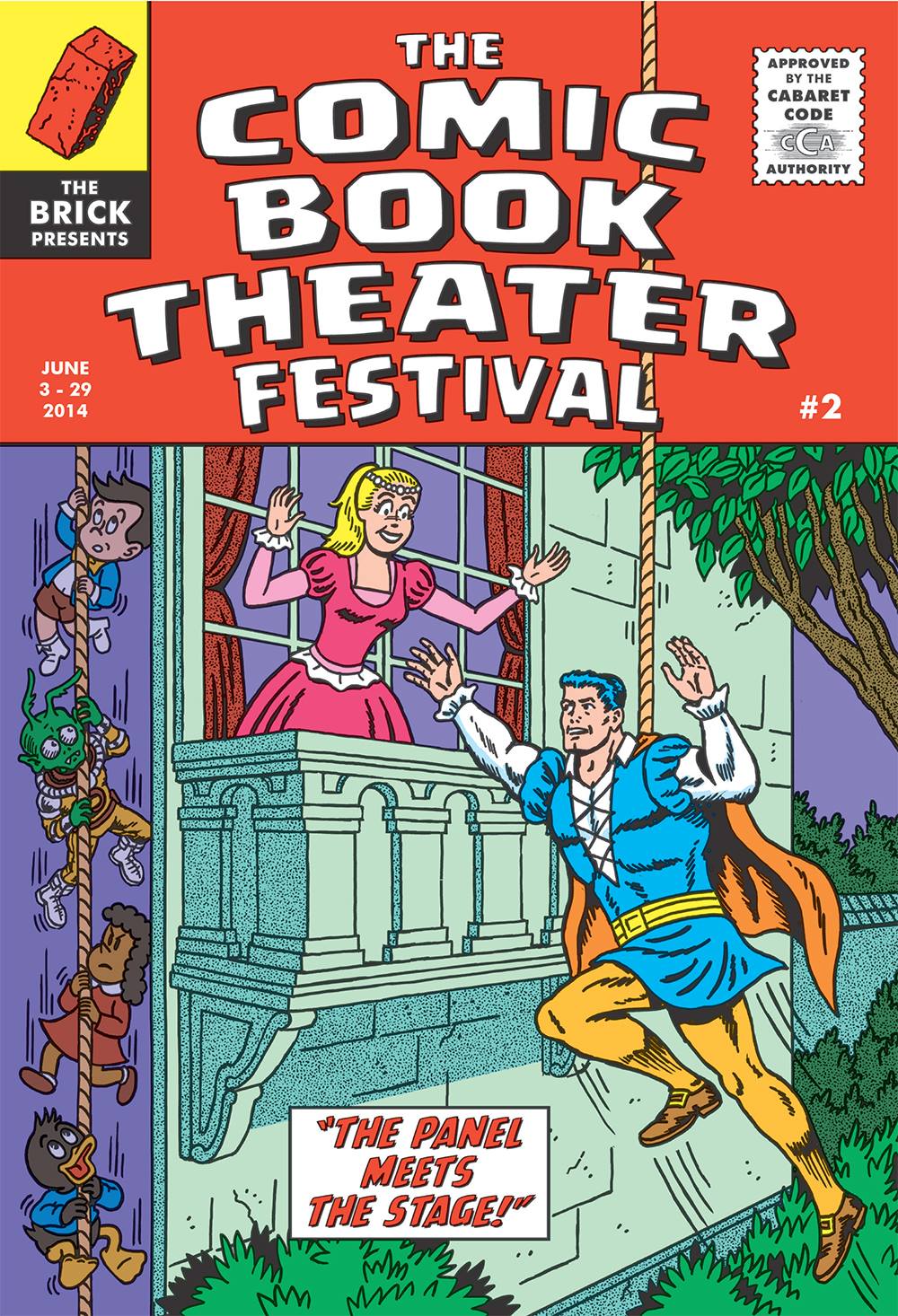 The Comic Book Theater Festival runs from June 3rd–29th at The Brick. Catch up on Part One of our coverage here and on Part Two here.
The Comic Book Theater Festival runs from June 3rd–29th at The Brick. Catch up on Part One of our coverage here and on Part Two here.
***
Part Three: Power Plays
Superheroes hold a special aspirational place as perhaps the only fantasy genre (from pirates to space-travel) that hasn’t actually happened yet. This may change with the rise of several cities’ doofus vigilantes and advances in performance-boosting drugs, but for now superbeings play out our inner struggles and our civic ones—several plays in The Brick’s Comic Book Theater Festival show superheroes, or their creators, embodying our fight for social acceptance, cultural visibility, commercial justice, and creative heritage, or our ambitions toward bodily transcendence through miraculous physical feats.
Superheroes are here to protect us from physical and societal harm; from satire, nobody is safe. Hence R. Sikoryak’s Masterpiece Comics Theater, its very title a pop reference conjunction of the writer-artist’s acclaimed Masterpiece Comics collection of cartoon makeovers of the classics and the long-running PBS reliquary of what’s for your own good. In Sikoryak’s comics, the figures of law-and-order authority and the pillars of daily routine are lampooned (the upstanding Batman remade as Raskolnikov; Charlie Brown waking up as Kafka’s cockroach), and onstage, sheathed in smoking jacket and smug expression, Sikoryak burlesques the kinds of experts who would tell us those superheroes and adorable tykes aren’t worthwhile.
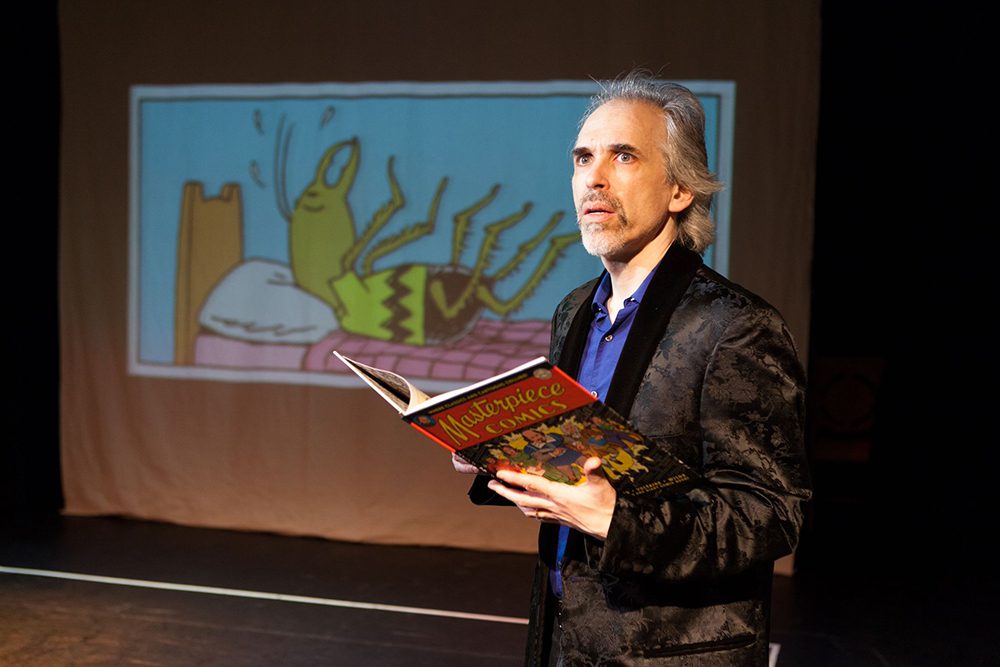 Sikoryak’s grounding in MAD Magazine verisimilitude serves him well—he stays in character for the high seriousness of his slaughter of both lowly comics’ conventions and serious literature’s assumptions. He’s long goaded the comic community with meaningful themes you might find more in Dostoyevsky’s psychological strata than in Frank Miller’s brooding veneer, and teased out the essential truths and direct stimulating structures that the literary world could stand not to trowel over with quite so much verbal density and self-importance. Heard aloud, from a small rabble of dedicated and sarcastic fine actors, the value and immediate appeal of his twist-tied sources is all the more startling, and familiar.
Sikoryak’s grounding in MAD Magazine verisimilitude serves him well—he stays in character for the high seriousness of his slaughter of both lowly comics’ conventions and serious literature’s assumptions. He’s long goaded the comic community with meaningful themes you might find more in Dostoyevsky’s psychological strata than in Frank Miller’s brooding veneer, and teased out the essential truths and direct stimulating structures that the literary world could stand not to trowel over with quite so much verbal density and self-importance. Heard aloud, from a small rabble of dedicated and sarcastic fine actors, the value and immediate appeal of his twist-tied sources is all the more startling, and familiar.
(Masterpiece Comics Theater played on June 14, 17 and 21, but R. Sikoryak’s other published and performance-based works can be followed at http://www.rsikoryak.com/)
*
A geek’s entire cataloging system comes to life in playwright Natalie Zutter’s slyly brilliant RETCONtroversy—but whose life is it, exactly?
We’re in the hideout of Echo, a surveillance wizard who monitors the criminal underworld after having been partially paralyzed by a sadistic villain in her superhero life as “Stinger.” Everyone will recognize her as a variant of Oracle, the former Batgirl/Barbara Gordon who spent some 20 years as a symbol of self-worth for the disabled community in pop culture.
But maybe everyone won’t remember her for long; existence is being reset so that Echo is about to be replaced by her earlier, superheroine self—preferable, we infer, as much for her youth as for her “whole”ness. This references a corporate whim infamous among many real-life fans, in which DC Comics’ “New 52” reboot of its storylines wiped out Oracle in favor of a young, able-bodied Batgirl (the “RETroactive CONtinuity” alluded to in the title). 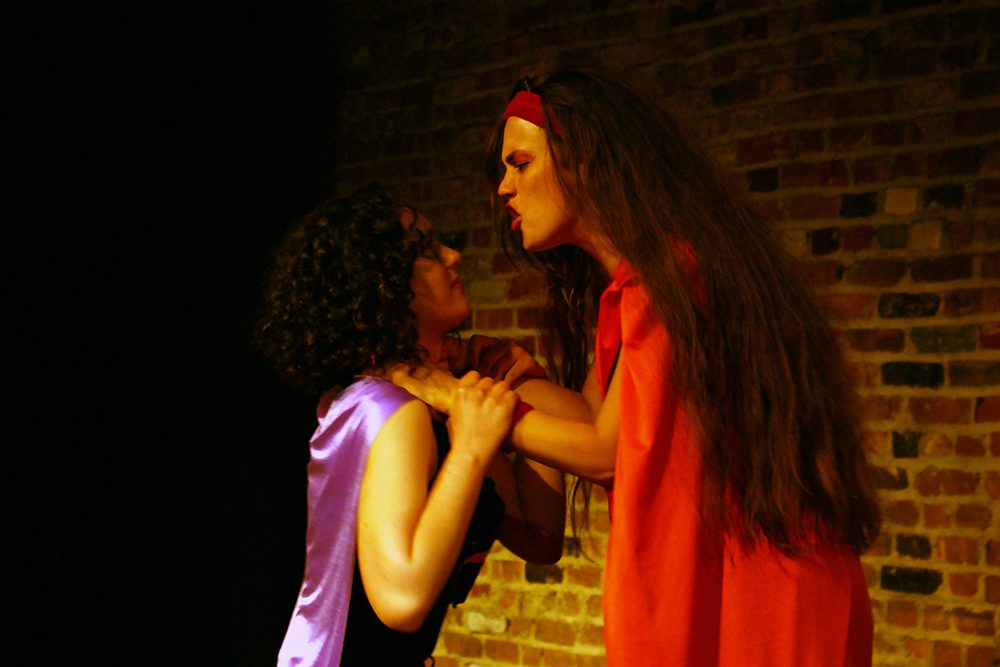 In Zutter’s play, this is a marketplace revision that the characters themselves, no strangers to parallel planes of reality, can actually sense and see coming.
In Zutter’s play, this is a marketplace revision that the characters themselves, no strangers to parallel planes of reality, can actually sense and see coming.
What Echo is really feeling is the onset of her devaluation by a disposal-prone society (especially for women), and so she kidnaps the new Stinger to try and prevent or delay her own displacement. We can hold on to our youth as tenaciously as this, or hold back those who come after us. It can split our consciousness: when a mature but dead third version of Stinger and a quickly-discontinued “evil” one also show up—neither of whom Echo remembers until she has to—we are in, indeed, an echo chamber of the woman’s psyche, a dialogue between all her most hopeful and doomed and benevolent and bitter selves.
Each persona gets to speak her piece about what compels her to exist, and Zutter, insightfully, puts us in suspense not about which of the antagonists will triumph but about how they might all reconcile. Each time we change, the person we were before, in some ways, dies. RETCONtroversy is an eloquent gem about what ways are worth living.
(RETCONtroversy’s run closes on June 28; for details and ticket information on this and other shows click here.)
*
Most comic creators’ characters have a secret identity that they can retreat to or a costumed persona that they can hide behind; Jack Kirby’s characters are usually all the hero they need, and can’t get away from what they are: Captain America is always on duty, Bruce Banner is forever walking the line that divides him from the Hulk, Orion knows he’s from a hellish gulag planet that scarred him in ways that the mechanisms of his adoptive heavenly home world help mask only cosmetically, and Ben Grimm is the Thing for his whole life no matter what’s inside.
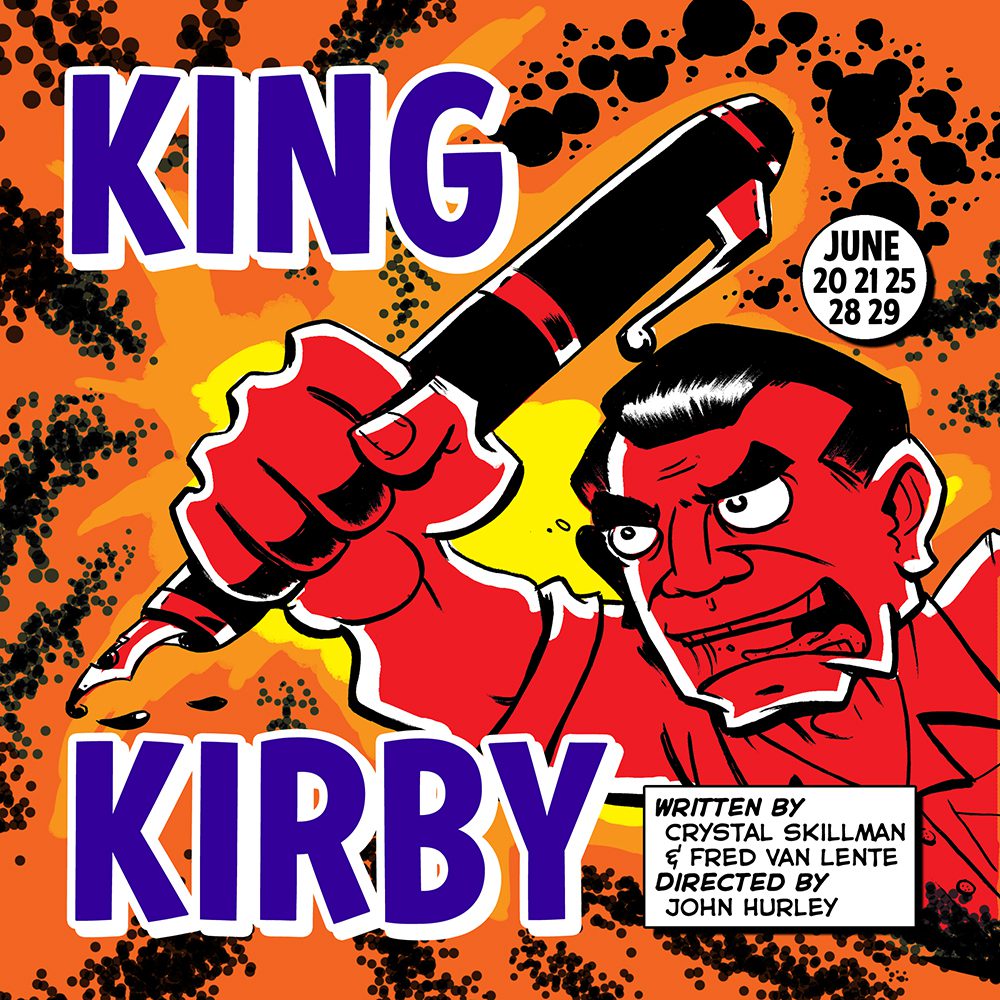 At two pivotal points in King Kirby, a phenomenal new bio-play by star indie dramatist Crystal Skillman and her husband, the definitive individualistic comics writer Fred Van Lente, Kirby (in a stoic powder keg performance by Steven Rattazzi) speaks of the different person he fears becoming—once, the murderer he sees himself as on the battlefields of World War II, and much later, the workhorse that entertainment-company suits see him as when he has to face them in boardrooms and courtrooms. Kirby had a sense of himself that was unshakable, and sometimes didn’t serve him. He kept his head down and produced a superhuman volume of work that defined much of comics’ vocabulary and that continues to inspire many of the medium’s other significant talents—but while he worked, others prospered, and for a long time took all credit.
At two pivotal points in King Kirby, a phenomenal new bio-play by star indie dramatist Crystal Skillman and her husband, the definitive individualistic comics writer Fred Van Lente, Kirby (in a stoic powder keg performance by Steven Rattazzi) speaks of the different person he fears becoming—once, the murderer he sees himself as on the battlefields of World War II, and much later, the workhorse that entertainment-company suits see him as when he has to face them in boardrooms and courtrooms. Kirby had a sense of himself that was unshakable, and sometimes didn’t serve him. He kept his head down and produced a superhuman volume of work that defined much of comics’ vocabulary and that continues to inspire many of the medium’s other significant talents—but while he worked, others prospered, and for a long time took all credit.
Most infamous among these is Stan Lee, co-creator of many of the modern legends Kirby is most known for, but there was a long line of exploiters along the way (including a number of malevolent comic publishers), and we meet them here all played by a hypnotically self-important Timothy McCown Reynolds, seen, through Kirby’s eyes, as one villain with a thousand faces.
Stan Lee stands out, in an aria of farce by Nat Cassidy—in real life Stan is an exceedingly nice guy around whom some epically wrong things tend to happen, and Cassidy preternaturally taps Lee’s affable, conflicted nature as a self-made myth who maintains his merry image while being the one who knows better than anyone what he isn’t. The real Lee is a formidably talented storyteller who is uncommonly dependent on the chemistry of his collaborations; he extolls his partners (in interviews if not in depositions), but what I don’t think I’ve ever heard him say is that he needs anyone.
Kirby, as portrayed here, needs to be needed—in life, credit was more important to him than compensation (which he was denied criminally). He thought his name could be wiped out by corporate whim. Ironically, in this play, we can see that name from the back row, when it appears, signed onto an agreement that bargains away his claim to ownership of the characters Marvel Comics already insists aren’t his, in return for possession of original art he wished to try and sell for the security of his family.
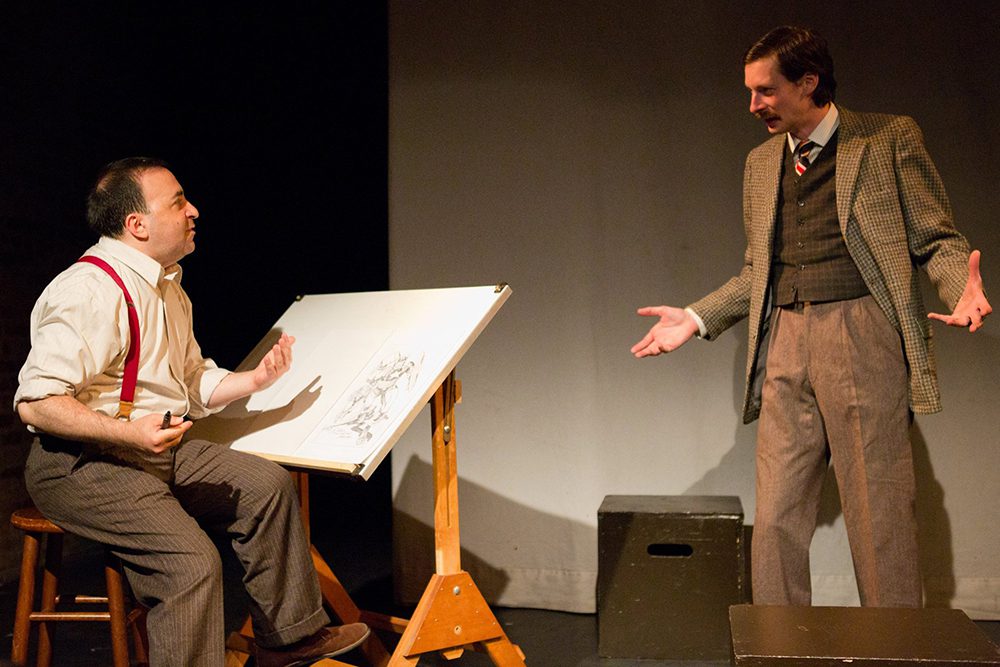 His wife, fierce guardian, and lifelong love, Roz (portrayed in a devastating performance of determined decency by Amy Lee Pearsall), wants him to be her “hero” and stand up for himself to the suits. But Kirby is traumatized by the combativeness he had no choice but to partake in as a ghetto kid in the ’30s and an unwilling soldier in the ’40s, and he wants to stay the family man he knows Roz and their kids need him to be.
His wife, fierce guardian, and lifelong love, Roz (portrayed in a devastating performance of determined decency by Amy Lee Pearsall), wants him to be her “hero” and stand up for himself to the suits. But Kirby is traumatized by the combativeness he had no choice but to partake in as a ghetto kid in the ’30s and an unwilling soldier in the ’40s, and he wants to stay the family man he knows Roz and their kids need him to be.
It’s possible that his sense of self is far too solitary, the tragedy of a strong individual who had very little power. Kirby was long known as part of something else—the name at the back of a creative team’s equation, like Lee & Kirby and before that, Simon & Kirby. But with Joe Simon, with whom he made Captain America and the millions-selling Boy Commandos, and with whom he remained friends forever (unlike with Lee), Kirby felt the equation to be balanced (and we can see why in a miraculously contained, humane performance by Joseph Mathers, which I found to be very true to the man I actually knew). We also see friendly friction between these two—Simon is the more smooth-talking businessman of the pair, and a more natural graduate to the middle class which Kirby had to climb doggedly into.
Skillman and Van Lente bring these social faultlines—and the same halcyon century’s cultural frontiers—uncannily to life, and director John Hurley orchestrates their collage of Kirby’s lifetime with vigor and vernacular majesty.
Kirby may never get his due in credit, copyrights, and compensation. But King Kirby does his inner character and creative legacy an enduring, enthralling justice.
(King Kirby goes two more rounds June 28 and 29; for details and ticket information on this and other shows click here.)
*
Comics exist to simulate the perception of motion in perfectly situated single images, while dance freezes that perfect position in your head through a blur of figures in action. Thoughtful gestures and balletic fights are the currency of indie art comics and superhero epics alike, so choreography in concert with comics is a natural if uncommon idea. And it’s an idea with impeccable timing in dancer and educator Patrice Miller’s Out of Frame: Dance+Comics, which she both curated and performs in.
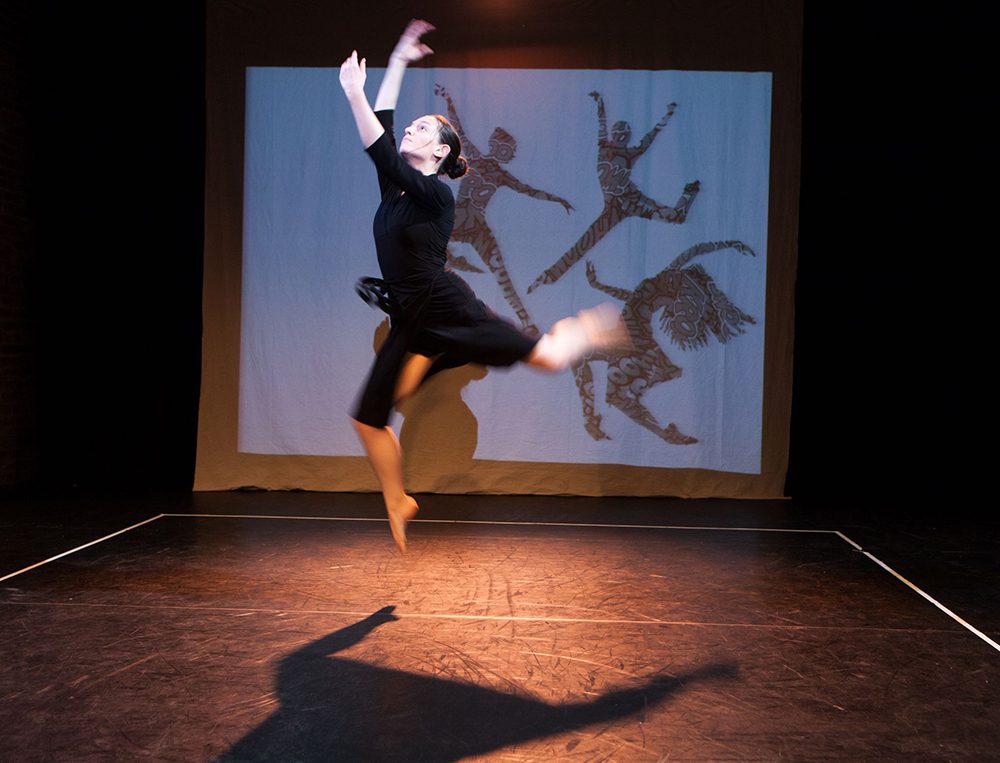 Miller herself choreographed six interludes titled after Marion Fayolle’s graphic collection In Pieces, which serves as a visionary material sketchpad of spatial possibilities to match the meaningful whimsy of Fayolle’s imagination. Miller eloquently dances the first piece, in which she performs in layers of clothing and paces of movement that match a climate projected on a screen behind her (trudging for the tundra, free for the sea). It was a conception of sequence as setting, and motion merged with the elements, that was an interesting variant on how comics fast-forward among visual cues for sensation.
Miller herself choreographed six interludes titled after Marion Fayolle’s graphic collection In Pieces, which serves as a visionary material sketchpad of spatial possibilities to match the meaningful whimsy of Fayolle’s imagination. Miller eloquently dances the first piece, in which she performs in layers of clothing and paces of movement that match a climate projected on a screen behind her (trudging for the tundra, free for the sea). It was a conception of sequence as setting, and motion merged with the elements, that was an interesting variant on how comics fast-forward among visual cues for sensation.
Other standouts in this series —in cage-like hoop-skirt skeletons, or literal tent-dresses that double as ironically immobilizing tablecloths for others to hide under—are Alexis Thomason, balancing acute focus and unforeseeable intuition and enacting rich wordless narratives, and Hope Cartelli, her face a ballet of comedic and concerned expressions to match her assured and unpredictable motions. Both are examples of the pure visual storytelling that comics stand or fall on. Chris Chappell’s score for these six vignettes was an art multiplex full of avant-garde hit B-sides in jazzy, moody, icy, and jingly genres that served as an invisible, unerring extra partner in the dance.
The artistry within well-constructed action is another silent partner in entertainments meant to be experienced rather than reflected on. Choreographer Emma Cotter’s HCI (High Claim Item) gave the common spy-adventure spectacle of the high-tech burglary a context all its own, with an original interpretation of a fine art museum heist complete with dancing ninja-thieves and a living painting, in a work which walks away with the treasure of creativity.
Rise of the Triple Helix, directed by Shana Solomon, and created and performed by a witty and agile company, brought gloriously to life the kind of superhero soap operas that Dean Haspiel specializes in, like The Red Hook and A-Okay Cool (though Haspiel’s own play in this same festival is a gangster noir, reviewed here last week). Following the love triangle of Captain Crush, the Rubber Maiden, and Mr. Marvelous, which could implode before they are able to foil the demonic Dr. Half-Life, this was one of the only dance pieces that included words, thus reintroducing a typically essential element of comics’ visual mix, albeit with a knowing intrusiveness. A crossover between the 1960s Batman TV show and West Side Story, midcentury tragic chic was hilariously re-created, with mere poses serving as action (some heroes strike them without moving while their enemies fall down) and, in other cases, motion conveying incident (as when the characters sway conspicuously on imaginary jet-skis, recalling the flailing of actors on the Enterprise bridge to signify a photon-torpedo hit). They could have had me at the human-pyramid-like suggestion of a fighter jet they’ve all piled into, but the crowd was also pleased (and maybe the planet taken over) by a series of YouTube, Bollywood, and other communal dances that the villain mind-controls the cast to do, a smart satire of Cold War-era paranoia about collective activity that sure looks like more fun than when the good guys and their law-and-order win at the end.
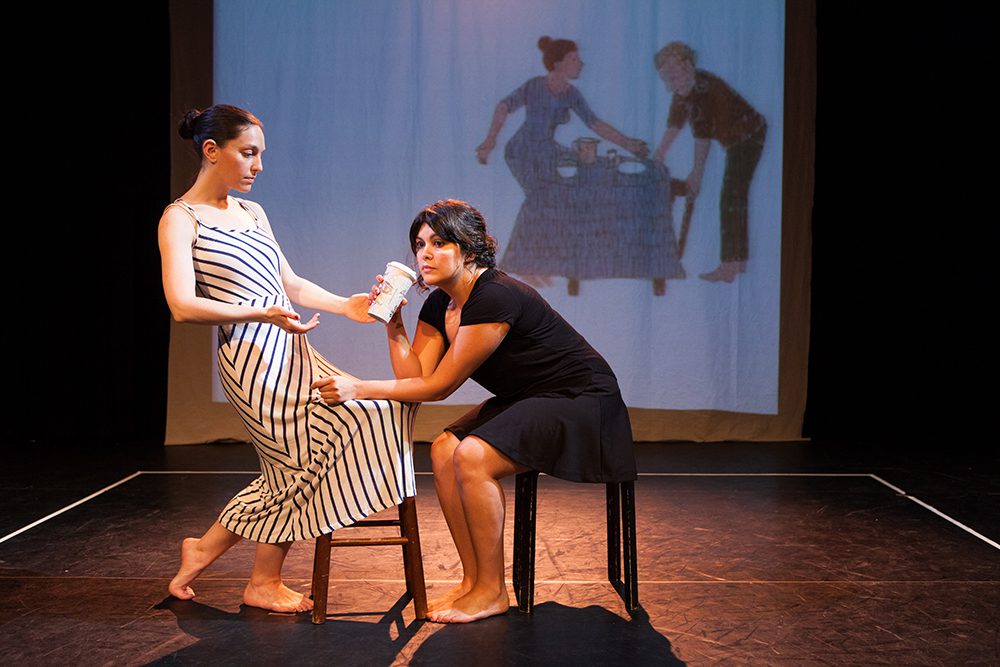 The last notable piece of the evening was Sketch #1, a lovely, eccentric duet by the supernaturally agile and emotive Ben Follensbee and Jody Oberfelder (the latter of whom also choreographed). The pair soared and mugged as if in some callisthenic Waiting for Godot, and were clad in simple, cheery outfits that made them seem to embody the pure planes of classic comics’ primary colors and elementary optimism.
The last notable piece of the evening was Sketch #1, a lovely, eccentric duet by the supernaturally agile and emotive Ben Follensbee and Jody Oberfelder (the latter of whom also choreographed). The pair soared and mugged as if in some callisthenic Waiting for Godot, and were clad in simple, cheery outfits that made them seem to embody the pure planes of classic comics’ primary colors and elementary optimism.
The first-night selection ended in a slightly anticlimactic attempted audience dance-along, which was sloppy, and silly, and real. My maxim for this festival had been Haspiel’s remark at an art opening a few weeks before that “I want to see real humans, making mistakes, in front of me,” and while we’re all only human, on most nights, including this one, the creators of The Comic Book Theater Festival rose to the superhuman, and did the right thing.
(Out of Frame keeps moving on June 28 and 29; for details and ticket information on this and other shows click here.)
***
Festival poster art by R. Sikoryak.
King Kirby poster art by Ryan Dunlavey.
Masterpiece and Out of Frame photos by Isaiah Tanenbaum; Stinger vs. Evil Stinger photo by Anton Nickel; Kirby and Lee photo by Hunter Canning.
